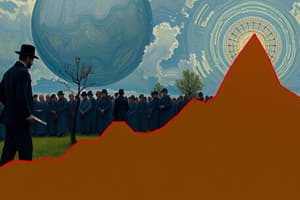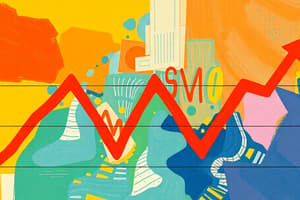Podcast
Questions and Answers
What factors affect the equilibrium unemployment rate 𝑢𝑛?
What factors affect the equilibrium unemployment rate 𝑢𝑛?
- The rate of inflation and consumer spending
- The price level and nominal wages
- The variable 𝑧 and the markup 𝑚 (correct)
- The unemployment benefits and tax rates
How is the natural rate of unemployment defined?
How is the natural rate of unemployment defined?
- When the unemployment benefits exceed the average wage
- When the real wage in wage setting equals the real wage in price setting (correct)
- When the unemployment rate equals the wage-setting rate
- As the maximum unemployment rate a country can achieve
What is the expected effect of an increase in unemployment benefits on the natural rate of unemployment?
What is the expected effect of an increase in unemployment benefits on the natural rate of unemployment?
- It has no effect on the natural rate of unemployment
- It causes a rightward shift in the wage-setting curve, increasing the natural rate (correct)
- It decreases the natural rate of unemployment
- It causes an immediate reduction in the unemployment rate
What happens to the price-setting curve when there is an increase in markup?
What happens to the price-setting curve when there is an increase in markup?
In the medium run, what tendency does output exhibit in relation to its natural level?
In the medium run, what tendency does output exhibit in relation to its natural level?
What does the unemployment rate represent?
What does the unemployment rate represent?
Which of the following is NOT a factor influencing the unemployment rate?
Which of the following is NOT a factor influencing the unemployment rate?
How does high unemployment affect employed workers?
How does high unemployment affect employed workers?
What characterizes an active labor market?
What characterizes an active labor market?
Which worker classification can complicate the unemployment measurement?
Which worker classification can complicate the unemployment measurement?
What is a common method for setting wages?
What is a common method for setting wages?
What trend is depicted by unemployment flows?
What trend is depicted by unemployment flows?
What does the employment rate measure?
What does the employment rate measure?
What does the variable 𝑧 represent in the context of wages?
What does the variable 𝑧 represent in the context of wages?
What is the production function defined in the content?
What is the production function defined in the content?
According to the price-setting relation, what determines the real wage paid by firms?
According to the price-setting relation, what determines the real wage paid by firms?
What happens to the real wage as the unemployment rate increases?
What happens to the real wage as the unemployment rate increases?
Given that 𝐴 is constant and equals 1, what does the equation Y = N imply?
Given that 𝐴 is constant and equals 1, what does the equation Y = N imply?
What is the role of the markup (𝑚) in the pricing equation P = 1 + 𝑚𝑊?
What is the role of the markup (𝑚) in the pricing equation P = 1 + 𝑚𝑊?
What happens after dividing both sides of the price-setting equation by nominal wage?
What happens after dividing both sides of the price-setting equation by nominal wage?
What does the relation between real wage and unemployment rate imply?
What does the relation between real wage and unemployment rate imply?
What typically influences the bargaining power of workers?
What typically influences the bargaining power of workers?
Which factor does NOT affect the aggregate nominal wage according to the equation provided?
Which factor does NOT affect the aggregate nominal wage according to the equation provided?
Why might firms pay above the reservation wage?
Why might firms pay above the reservation wage?
How does a low unemployment rate impact wages?
How does a low unemployment rate impact wages?
In terms of wage determination, what does the efficiency wage theory suggest?
In terms of wage determination, what does the efficiency wage theory suggest?
What happens to wages when unemployment increases?
What happens to wages when unemployment increases?
Which statement regarding collective bargaining is accurate?
Which statement regarding collective bargaining is accurate?
Which statement reflects the role of nominal wages in wage determination?
Which statement reflects the role of nominal wages in wage determination?
Flashcards
Natural Rate of Unemployment
Natural Rate of Unemployment
The unemployment rate that occurs when the labor market is in equilibrium. It is the rate where the real wage in the wage-setting and price-setting equations are equal.
Impact of Unemployment Benefits on Natural Rate
Impact of Unemployment Benefits on Natural Rate
An increase in unemployment benefits shifts the wage-setting curve upwards, leading to a higher real wage for any given unemployment rate. This results in a higher natural rate of unemployment.
Impact of Markup on Natural Rate
Impact of Markup on Natural Rate
An increase in the markup (the difference between price and marginal cost) shifts the price-setting curve downwards, leading to a lower real wage for any given unemployment rate. This results in a higher natural rate of unemployment.
Equation (7.7): Equilibrium Unemployment Rate
Equation (7.7): Equilibrium Unemployment Rate
Signup and view all the flashcards
Short-run vs. Medium-run Output
Short-run vs. Medium-run Output
Signup and view all the flashcards
Unemployment Rate
Unemployment Rate
Signup and view all the flashcards
Active Labor Market
Active Labor Market
Signup and view all the flashcards
Sclerotic Labor Market
Sclerotic Labor Market
Signup and view all the flashcards
Average Duration of Unemployment
Average Duration of Unemployment
Signup and view all the flashcards
Out of the Labor Force
Out of the Labor Force
Signup and view all the flashcards
Employment Rate
Employment Rate
Signup and view all the flashcards
Collective Bargaining
Collective Bargaining
Signup and view all the flashcards
Wage Determination
Wage Determination
Signup and view all the flashcards
z
z
Signup and view all the flashcards
Production function
Production function
Signup and view all the flashcards
Labor productivity (A)
Labor productivity (A)
Signup and view all the flashcards
Marginal cost of production
Marginal cost of production
Signup and view all the flashcards
Price-setting equation
Price-setting equation
Signup and view all the flashcards
Wage-setting relation
Wage-setting relation
Signup and view all the flashcards
Price-setting relation
Price-setting relation
Signup and view all the flashcards
Wage determination equation
Wage determination equation
Signup and view all the flashcards
Reservation Wage
Reservation Wage
Signup and view all the flashcards
Efficiency Wage Theories
Efficiency Wage Theories
Signup and view all the flashcards
Nominal Wage
Nominal Wage
Signup and view all the flashcards
Real Wage
Real Wage
Signup and view all the flashcards
Wage Equation
Wage Equation
Signup and view all the flashcards
Study Notes
The Labour Market
- The labour market is central to understanding the medium-run adjustment of prices and wages, affecting output.
- Unemployment rate is the ratio of the unemployed to the labor force.
- An active labor market has many separations and hires.
- In a sclerotic labor market, there are few separations and hires, and a stagnant unemployment pool.
- Separations include quits and layoffs.
- The average duration of unemployment is the length of time people spend unemployed.
Unemployment Rate
- Unemployment rate can show either an active or sclerotic labor market.
- Discouraged workers aren't actively seeking work but would accept it if offered, and are counted as "out of the labor force."
- Economists sometimes focus on the employment rate (ratio of employment to the population) instead of the unemployment rate.
Wage Determination
- Wages are sometimes set by collective bargaining (between unions and firms).
- Slightly more than 10% of U.S. workers' wages are set this way.
- Higher skill jobs are more likely to have bargaining between employers and individual employees.
- Collective bargaining is significant in Japan and most European countries.
- Workers are usually paid above their reservation wage (the wage at which they are indifferent between working or being unemployed).
- Wages depend on labor market conditions; lower unemployment rates correlate with higher wages.
- Workers' bargaining power depends on the cost of firms finding new workers and how easily workers can find new jobs elsewhere.
- Efficiency wage theory links worker productivity to wages.
- Firms may pay above the reservation wage to reduce worker turnover and boost productivity.
Wage Determination
- The aggregate nominal wage (W) depends on the expected price level (Pe), unemployment rate (u), and a catch-all variable (z).
- W = Pe F(u, z) (-, +).
- Workers and firms focus on real wages (W/P), not nominal wages.
- Nominal wages depend on the expected price level, not the actual price level.
Wage Determination
- An increase in the unemployment rate typically leads to lower wages. This can either weaken workers' bargaining power or permit firms to pay lower wages.
- Factors (z) affecting wage determination include unemployment insurance and employment protection laws.
Price Determination
- Firm prices depend on costs and production function (Y = AN).
- Y is output, N is employment, and A is labor productivity (output per worker).
- Marginal cost of production is equal to the wage (W).
- Firms often set prices using a markup (m) over cost.
- P = (1 + m)W.
Wage Determination
- If the wage (W) depends on the actual price level (P) rather than the expected price level (Pe), then W/P = F(u, z).
- Higher the unemployment rate, lower the real wage chosen by wage setters.
- Price-setting relation: W/P = 1 / (1 + m)
Price Determination
- Dividing the price determination equation by the nominal wage gives the price-setting relation: W/P = 1 / (1 + m).
- Price-setting decisions directly affect the real wage paid by firms.
The Equilibrium Unemployment Rate
- Equilibrium unemployment rate (un) is derived by equating the wage-setting and price-setting relations.
- un depends on z and m.
- It's also known as the natural rate or structural rate of unemployment.
The Natural Rate of Unemployment
- The natural rate of unemployment is the rate at which the real wage chosen in the wage-setting relation equals the real wage implied by the price-setting relation.
Comparative Statics
- An increase in unemployment benefits raises the natural rate of unemployment.
- The wage-setting curve shifts right/up.
- An increase in the markup also increases the natural rate of unemployment.
- The price-setting curve shifts down.
Short-Term and Medium-Term
- In the short run, price levels may differ from expected price levels, leading to unemployment rates different from the natural rate, or output levels different from the natural level.
- Output tends to return to its natural level in the medium run due to the consistency of expectations.
Studying That Suits You
Use AI to generate personalized quizzes and flashcards to suit your learning preferences.
Related Documents
Description
This quiz delves into the intricacies of the labour market and its impact on prices, wages, and output. It explores concepts such as unemployment rates, types of labour markets, and wage determination through collective bargaining. Test your knowledge on how these elements shape employment dynamics.




